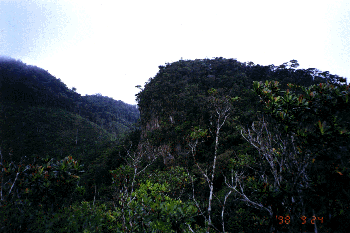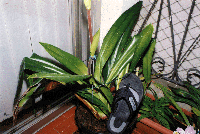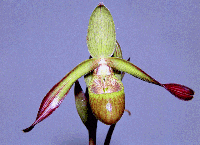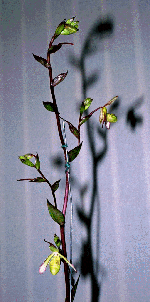
NO.10 -2�@Phragmipedium World in Brazil |
Mr. Robert Takase �@�iBrazil�j |
The habitat of Phrag. lindleyanum |
| Recently, a friend of mine who went to the Phrag. lindleyanum habitat was with fear to go exactly by side the plants unfortunately. He also reports that a storm arrives at the place in the moment to begin the climb, and you shold know how dificult is climb and walk in the jungle specialy in the rain. Also he doesn't bring with him a water proof camera- he is an amateur. In near future, I intend to go personaly in this place and take very good pictures to send you, please be pacient. |
|
| The fist photo is the nearest he could take before the rain arrives: In fist place you can see the granitic clif covered by vegetation and in the borders is were Phragmipedium lindleyanum ocours. In second place can you see also the deforastation wich is on process in that area a terrible scene to be seen.The place of the pictures are in Soth of the distric of Bahia. |
| The place is not much far from the Ocean ( +- 60 Km ) and once a week the cold fronts ( cold air from south) arrives at this place specialy in winter months - june throw setember- bringing rain fall, also the air humidity is high due to the wet air coming from the near ocean , this humid air as it get up the montains make the "fog" fenomenum every nigth and the nescessary water is suplyed to them. the big colony is located just a few meters from the border of the clift covered by the trees( in the photo just above the rocky vertical wall in the left) the soil is fully covered by leaf mold and the roots get into this substract deeply. The clift is faced East -southeast reciving moorning sun light. I forget to tell you that this place is the SECOND PLACE this Phrag is found and is about 30 Km south from the first one . That new place is facinating bacause no water fall is nearby, in the first there is one. The size of the native plants are very big also indicating a stable population and a species status. |
|
| The second photo is a view from down valley in the uper montains quite just before arriving at the point of the fist photo, looking backwards of course. As you see more devastation into the jungle. |
| In my collection I have almost all the Phragmipedia existing in South America, wich are :P. vittatum , sargentianum , lindleyanum , longifolium , carricinum , caudatum ,ecuadorense , wallisii ,lindeny ,boisseranum , reticulatum , hirtzii , besae , and some hibrids such as schoederae , eric young , andean fire, sedenii ,.etc.. I'll make a full list of them. Of course not all of them I have pictures because they have not yet flowered but this will be a good year and the missing ones I supose get pictured. |
 |
The size of the native plants ( the shoe pictured is my size 39- brasilian size sorry I don't know the equivalent in international measure) |
| A close-up of sataminoidal shape of this plant. In the text is reported a variety of Phragmipedium lindleyanum called " Phragmipedium lindleyanum var. superba" wich difers from the normal kind exactly by the size of the leaves, of corse we know that native plants grow in perfect condictions ad get very large as much as possible but not 100% more than the ones cultivated in green houses- isn't this true also for Paphiopediluns that you grow? |
|
| Also the pictured plant is NOT the bigest one from the colony- they are realy very large don't you agree with me? Just for curiosity , the other kinds of orchids that are found in this place are: Catleya amethystoglossa, Laelia alaori and a miriad of microorchids such as Pleurotalis etc... . |
| In Oct.1998, Here in my city the rain season starts earlyier them the expected, but all the way my plantsare opening their's flowers. |
|
This photo is the opened flower of the Phrag ecuadorense , I've seen the bud and spike in upper. The photo was taked using a close up lens over a 75-150 mm Nikon E lenses. It's very small flower no more than 2.8 cm labelum(pouch) |
| This photo is of the caudatum with the respective 1st prize in his category in our societies' orchid show in this year. In detail, please see the other site that is in the orchid friends in the world. |
|
|
|
| This is just a view of what it will be, it's still opening his flowers today. In a week, all of flowers will be opened and I'll send you the photo. | This photo is from the bigest spike of the Phrag caudatum |
|
|
| This flower is an hibrid Phragmipedium Schoederae ( caudatum X Sedenii (longifolium x schlimii)). The peculiarity of this plant is that it's growed hanged in plastic pot im high light intensity just as for catleya walkeriana - That is an sperience that I'm doing. it takes one full year for this plant get flowered , because of adaptation but once adapted it will flower ,I supose, every year. The intention is to certify that caudatun it's hibrids can tolerate more light than lorifolia and platipetalum groups of Phragmipediuns. |
| This is not a good photo of the flower of Phragmipedium Hirtzii, as I get it from a division of a friend's plant, with flower , but should be better maybe next year. When this hapens I'll send the good photos of it. |
|
Phragmipedium sargentianum |
 |
|
| from Pernambuco state | This plant grows in shadier condition in nature. |
| These flowers are identified Phrag. sargentianum from staminoid shape for the "Alagoas " variety but a litle diference in the ondulation on the petals are observed. The shape of the flower in both are similar and also size is quite the same but in the "Alagoas" variety is bigger that is just to position yourself. So what interisting this is I mean, the color of the one of shadier is less intense, but both of them are grown in my green house and recive the same amount of light and why they get diferent colours? potting material are the same, fertilizer also that is a mistery to solve. |
 |
This is the first opened flower of Phrag. sargentianum. See the staminoid shape, diferent fron the normal sargentianum species. This flower was born in greener than normal. In truth, I get afraid in growing this plant in ligther condition, but now I know it can get more ligth as the native place. Here I have less insolation than in Bahia State. |
 |
As you can see the spike of both does not branches, nether in the "Alagoas" variety but in the Phragmipedium lindleyanum the spike do branches and that is considered one of the diferences between the two species. The book I've got the draws says exactly this diference is important to distinguish the two species. I'm sending the photo of the branched spike of the Phragmipedium lindleyanum too. By now it is this I want to show you. |
Continue to NO.8 |
Back to Dr. Tanaka's Homepage |